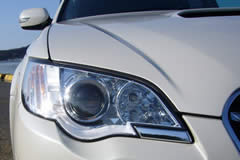What Are The Functions Of Specific Lights/Lenses On The Car? - Vol.215
As vehicles become more and more packed with safety and luxury features, it can be harder to tell the difference between what does what. Here is a brief summary of all the lights and lenses so that you know exactly what they do and when to use them.

Front & Rear Fog Lights
Front fog lights are usually located directly near the bumper on a car or within the vicinity of your headlights, and are intended for use in poor weather conditions where your headlines might not help. The reason that these lights are installed instead of just using your headlights is that they direct a beam of light underneath the level of fog or mist on the ground to help you better see the road and stay within your lane; Headlights only direct the beam of light straight forward at your level which might not help with fog.
Rear fog lights are bright red and help to let passengers who are following behind you know where you are at all times. These lights can help to prevent collisions if you absolutely have to drive in poor weather conditions, but you should avoid the road if possible.
Headlights & High beams
Headlights?also known as low beams?are there to assist you when driving at night. They can also help alert other drivers of your location if you find yourself in rain, snow, or other poor weather conditions where it is hard to see.
High beams are used to provide you within much greater light if you are driving in remote areas or require additional visibility. These lights can be helpful when you are driving in areas that known for wild animals crossing the road, as you'll have more time to react and prevent killing the animal and damaging your car. Remember to turn off your high beams when you are passing fellow motorists and do not use high beams when you are driving through heavy rain or fog as this could cause reflection and pose a hazard.
Driving Lights
Driving lights are an optional feature on some vehicles that are located on the grill of your vehicle. They are primarily used on remote or country roads and should be used sparingly, much like the use of your high beams.
Dashboard Lights
Dashboard lights are installed on vehicles to alert you if your car is experiencing mechanical problems that needs to be addressed or looked at. Every picture or word that pops up on the screen has a correlating purpose. Some of the most common symbols include:
- Check Engine ? Picture appears to be an engine block; indicates a problem with the engine that can be diagnosed using a specialty tool to obtain an error code. Take this code with you to a mechanic to have remedied.
- Coolant Temperature Warning ? Pictures looks like a thermometer inside water; temperature of the engine is too high. The coolant may be low or have leaks.
- Oil Pressure Warning ? Picture looks like an oil can; loss of oil pressure as a result of low oil levels or leak.
- Brake System ? Picture is a exclamation mark inside a circle; emergency break is still on or problem with the anti-lock brake system (ABS).
Hazards
The hazards can be initiated using a switch or button within your cab. The purposes of the hazards are to flash all of your turn signals and lights on the surrounding vehicle to let other motorists know to use caution. These may be used in the event of an emergency or if you have to come to a stop on a busy roadway.
Turn Signal
Turn signals are located on the back and front of the vehicle and can be started by pulling a lever located next to the steering wheel. These lights indicate to other drivers the direction that you are turning, whether that be left or right, so that they can use caution and know when to slow down if they are driving behind you.